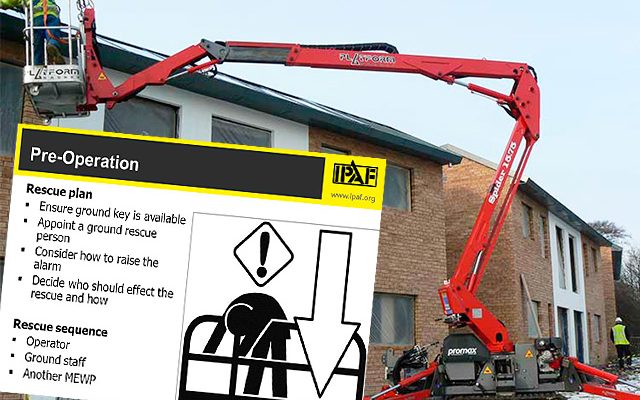
MEWP Rescue Plan
Be Ready For When Things Go Wrong
Powered access platforms such as spider lifts and compact cranes are the safest way to work at height in most circumstances. However, there are occasions when things can go wrong. The key to a successful MEWP rescue plan starts with a comprehensive Risk Assessment. This includes the following essential information:
• The Manufacturer / model / ID number
• Location of use
• Date, times and duration of the MEWP rescue plan
• Ensure a ground key is available
• Appoint a ground person(s) onsite, familiarised and authorised to lower the work platform in the event of an emergency or a machine malfunction
• Best ways to raise the alarm
• Who should effect the rescue and how
• Name and contact number of authorised service engineer (if needed to call)
• And record Date the Rescue Plan was last practised
Carrying out a detailed and thorough risk assessment of the job location will identify most of the potential hazards before the job starts. But sometimes human error or acts of nature, such as extreme weather conditions, can mean that things still go wrong. It is important to have a rescue plan in place to support and assist the workforce in case of an accident or mechanical failure.
Your MEWP Rescue Plan
Most access equipment has back-up systems built into the machine. This allows the operator to return the raised platform back to ground level. Though these systems rarely fail it can still happen, so it is vital to have a MEWP rescue plan for how people can be brought down safely. Not only is it important to have a plan for rescuing someone from a MEWP, but it just as important to practise it. Someone on the ground should know what to do in an emergency and how to operate the machine’s ground controls.
Any rescue plan from an access platform should comply with the current health and safety legislation covered by the 2005 Work at Height Regulations. It is important to do a risk assessment for the rescue and keep a record of this assessment. More information regarding controlling the risk of MEWP hazards can be found on the Health and Safety Executive website.
Actioning a MEWP Rescue Plan
• Activate all normal emergency lowering procedures if possible
• Contact the manager of the site or project to report any failure of backup emergency systems
• Get the powered access platform checked by a qualified engineer to see if an onsite repair can be carried out
Basket-To-Basket Rescue
If it is not possible to repair the lowering mechanisms then a basket-to-basket rescue may be necessary. This can be complicated and poses additional health and safety risks so it is important to follow the following steps:
• The rescue machine should be placed in the safest position to minimise any additional danger to anyone involved in the rescue
• Place the two machines adjacent to each other with the smallest possible gap between them
• Attach a double lanyard to both the person being rescued and the anchor points on both machines before the rescue takes place
• Never overload the rescue machine as this could lead to over-tipping or delay the rescue operation
• In exceptional circumstances where a basket-to-basket rescue is not feasible, emergency evacuation systems such as a crane rescue could be used.
Summary
Having a MEWP rescue plan is an essential part of planning a job. Though access equipment is safe and efficient, there are rare occasions when jobs don’t go to plan. Carry out a full risk assessment, keep a record of any rescue situation as it happens. Always try the simplest solution first before attempting a more complicated rescue procedure. The best situation is to resolve the problem quickly and carefully. And remember to practice for such an event.